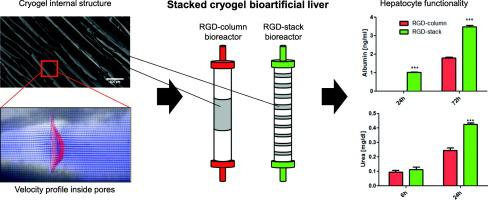Biomaterials Advances ( IF 7.9 ) Pub Date : 2021-02-23 , DOI: 10.1016/j.msec.2021.111983 Flavia Bonalumi , Cyril Crua , Irina N. Savina , Nathan Davies , Abeba Habstesion , Maurizio Santini , Stephanie Fest-Santini , Susan Sandeman

|
Bioartificial Liver (BAL) devices are extracorporeal systems designed to support or recover hepatic function in patients with liver failure. The design of an effective BAL remains an open challenge since it requires a complex co-optimisation of cell colonisation, biomaterial scaffold and BAL fluid dynamics. Building on previous evidence of suitability as a blood perfusion device for detoxification, the current study investigated the use of RGD-containing p(HEMA)-alginate cryogels as BAL scaffolds. Cryogels were modified with alginate to reduce protein fouling and functionalised with an RGD-containing peptide to increase hepatocyte adhesion. A novel approach for characterisation of the internal flow through the porous matrix was developed by employing Particle Image Velocimetry (PIV) to visualise flow inside cryogels. Based on PIV results, which showed the laminar nature of flow inside cryogel pores, a multi-layered bioreactor composed of spaced cryogel discs was designed to improve blood/hepatocyte mass exchange. The stacked bioreactor showed a significantly higher production of albumin and urea compared to the column version, with improved cell colonisation and proliferation over time. The cell-free cryogel-based device was tested for safety in a bile-duct ligation model of liver cirrhosis. Thus, a stacked bioreactor prototype was developed based on a surface-engineered cryogel design with optimised fluid dynamics for BAL use.
中文翻译:

使用粒子图像测速仪对冷冻凝胶衍生的生物人工肝进行生物工程定义的流体动力学
生物人工肝(BAL)设备是体外系统,旨在支持或恢复肝衰竭患者的肝功能。有效的BAL的设计仍然是一个开放的挑战,因为它需要对细胞定植,生物材料支架和BAL流体动力学进行复杂的共同优化。基于先前的证据证明其适合作为血液灌流装置进行排毒,目前的研究调查了将含RGD的p(HEMA)-海藻酸盐冷冻凝胶作为BAL支架的用途。用藻酸盐修饰冰冷蛋白以减少蛋白质结垢,并用含RGD的肽进行功能化以增加肝细胞粘附。通过使用粒子图像测速(PIV)可视化冰晶格内部的流动,开发了一种表征通过多孔基质的内部流动的新颖方法。根据PIV结果,为了显示冷冻凝胶孔内部流动的层流性质,设计了由间隔开的冷冻凝胶盘组成的多层生物反应器,以改善血液/肝细胞的质量交换。与柱型相比,堆叠的生物反应器显示出明显更高的白蛋白和尿素产量,并且随着时间的推移细胞定植和增殖得以改善。在肝硬化的胆管结扎模型中测试了基于无细胞冷冻凝胶的装置的安全性。因此,基于表面工程冷冻凝胶设计开发了堆叠式生物反应器原型,并为BAL使用了优化的流体动力学。与柱型相比,堆叠的生物反应器显示出明显更高的白蛋白和尿素产量,并且随着时间的推移细胞定植和增殖得以改善。在肝硬化的胆管结扎模型中测试了基于无细胞冷冻凝胶的装置的安全性。因此,基于表面工程冷冻凝胶设计开发了堆叠式生物反应器原型,并为BAL使用了优化的流体动力学。与柱型相比,堆叠的生物反应器显示出明显更高的白蛋白和尿素产量,并且随着时间的推移细胞定植和增殖得以改善。在肝硬化的胆管结扎模型中测试了基于无细胞冷冻凝胶的装置的安全性。因此,基于表面工程冷冻凝胶设计开发了堆叠式生物反应器原型,并为BAL使用了优化的流体动力学。


























 京公网安备 11010802027423号
京公网安备 11010802027423号